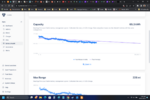All searches regarding battery degradation lead to, 10% average first year, got it. Question is, what's the normal loss curve look like? I ask because I feel my car's rate is extreme, but have nothing to compare to for reference. Estimated miles dropped off gradually the first 1,300 miles. I get this is driving habit, etc. Then at 1,400 miles, the estimated range has taken a nose dive. I loss range every other charge. I understand driving habits, but my driving habits are very very consistent. So, I'm not buying that at this point. It started at 315mi at 100% it's now down to 298mi at 100%. In fact my wh/m are down lately, most likely due to the 2 extra psi I added to the tires. I'm not so worried about the miles themselves as I am the rate of decline. Hence, what is a normal rate of decline.
For reference. I drive 3 days a week, the same route, distance, etc. each week, 98% of the time. I only put 80 miles a week on the car. I don't supercharge, and I only charge to 50%-65%. I do not charge every day, and I do not allow it to drop below 30%.
Thoughts??
For reference. I drive 3 days a week, the same route, distance, etc. each week, 98% of the time. I only put 80 miles a week on the car. I don't supercharge, and I only charge to 50%-65%. I do not charge every day, and I do not allow it to drop below 30%.
Thoughts??



